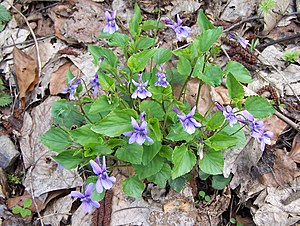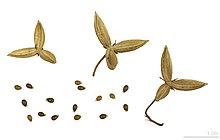Forest violets
| Forest violets | ||||||||||||
|---|---|---|---|---|---|---|---|---|---|---|---|---|

Forest violets ( Violareichenbachiana ) |
||||||||||||
| Systematics | ||||||||||||
|
||||||||||||
| Scientific name | ||||||||||||
| Violareichenbachiana | ||||||||||||
| Boreau |
The forest violet ( Violareichenbachiana ) is a species of the violet ( Viola ) genus .
description

The forest violet grows as a perennial herbaceous plant and reaches heights of up to 25 centimeters. The leaf blade of the summer leaves is pointed and heart-shaped at the base. Stems and leaves are hairless. There are leaves at the base of the stem - in contrast to the dog violet .
A striking difference to the grove violet is the shortness of the calyx appendages of only about 1 mm - as can be seen in the adjacent profile view of the flower . In addition, the upper petals are narrower and hardly or not at all overlap. The lower petal has violet veins on a white background. Otherwise the flower color is light purple. The flower spur is colored dark purple.
The forest violet can easily be confused with the hybrid Viola x bavarica ( Bavarian violet ).
The flowering period extends mainly from March to May. Occasionally, however, you can still find blooming specimens in late summer.
The chromosome number of the species is 2n = 20.
ecology
The forest violet is a rosette plant with leafy, axillary inflorescences. A vegetative reproduction occurs through rhizomes and root shoots.
Even the open flowers in spring produce seeds . Self-pollination takes place in the so-called cleistogamic flowers that remain closed .
The fruits are desiccant spreaders with a spreading width of up to 4.7 m. There is myrmecochory place (ants spread). The fruit ripens between June and August.
Occurrence
As a location, this plant species prefers moderately sparse forests on fresh, nutrient-rich, neutral to moderately acidic, humus-rich loamy soils. It is a cheesecloth plant. In terms of plant sociology, it is a Fagetalia order character in Central Europe.
Systematics
The first description was in 1857 by the French botanist Claude Thomas Alexis Jordan in Fl. center France , 3rd edition, volume 2, p. 78. The specific epithetrichbachiana honors the German botanist Heinrich Gottlieb Ludwig Reichenbach .
Synonyms for Violareichenbachiana Boreau are: Viola arenicola Chabert , Viola formosa Vuk. , Viola sylvatica (Hartm.) Fr. ex Hartm. , Viola sylvestris auct.
literature
- Werner Rothmaler , E. Jäger, Klaus Werner: Excursion flora from Germany. Vol. 2. Vascular plants, base volume. Fischer, Jena 1958, Spektrum Akad. Verlag, Heidelberg 2000. ISBN 3-334-60831-X , ISBN 3-8274-0912-8
- Ruprecht Düll , Herfried Kutzelnigg : Pocket dictionary of plants in Germany and neighboring countries. The most common Central European species in portrait . 7th, corrected and enlarged edition. Quelle & Meyer, Wiebelsheim 2011, ISBN 978-3-494-01424-1 . (Section ecology)
Single references
- ↑ a b Erich Oberdorfer : Plant-sociological excursion flora for Germany and neighboring areas . 8th edition. Page 676. Stuttgart, Verlag Eugen Ulmer, 2001. ISBN 3-8001-3131-5
- ↑ Entry in GRIN Taxonomy for Plants .
Web links
- Forest violets. In: FloraWeb.de.
- Profile and distribution map for Bavaria . In: Botanical Information Hub of Bavaria .
- Forest violets . In: BiolFlor, the database of biological-ecological characteristics of the flora of Germany.
- Violareichenbachiana Boreau In: Info Flora , the national data and information center for Swiss flora . Retrieved December 25, 2015.
- Distribution in the northern hemisphere according to Eric Hultén
- Thomas Meyer: Data sheet with identification key and photos at Flora-de: Flora von Deutschland (old name of the website: Flowers in Swabia )

